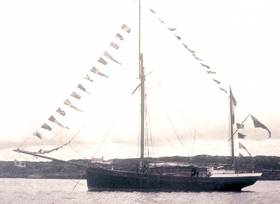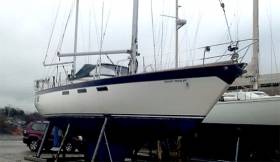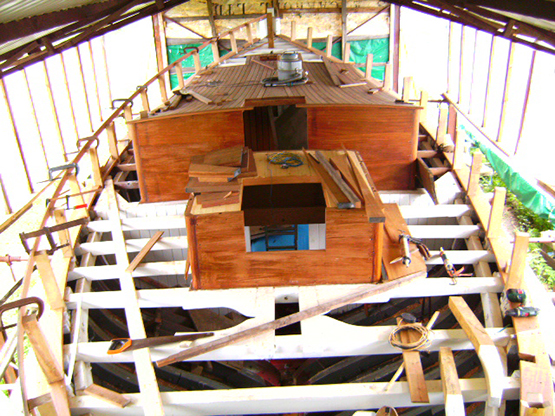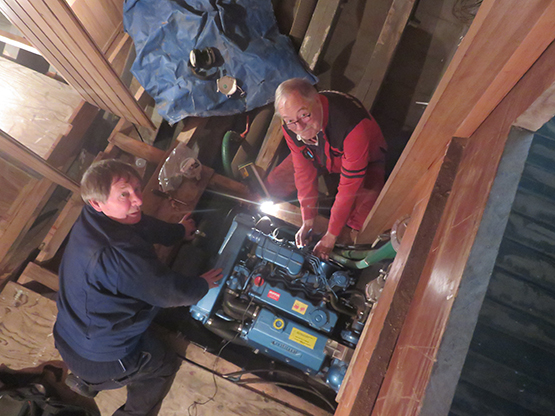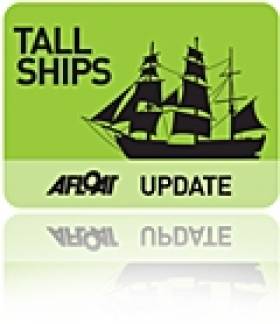Displaying items by tag: Ketch
Restored Historic Ketch Ilen Starts to Get Authentic Rigging Through In-House Production
When the restoration project on the 1926-built 56ft Conor O’Brien/Tom Moynihan Falkland Islands Trading Ketch got under way at two locations – Liam Hegarty’s boat-building shed in the former Cornstore at Oldcourt near Baltimore, and the Ilen Boat-building School premises in Limerick – it was expected that final jobs such as making up the rigging and creating the sails would be contracted out to specialists writes W M Nixon.
But while the plan is still in place to have the sails made in traditional style by specialist sailmakers, Gary MacMahon and his team in the Ilen Boat-building School came to the realisation that they’d made so many international contacts over the years while the restoration has been under way that, if they could just get the right people’s schedules to harmonise, then they could learn how to make up the rigging in their own workshops as part of the broader training programme.
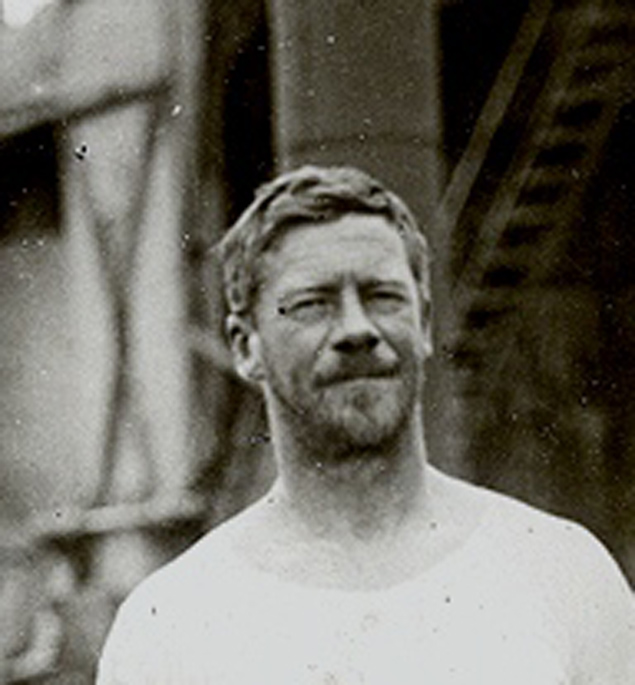 Conor O’Brien in 1926, when he delivered Ilen to the Falklands. He had received the order for the new ketch as a result of his visit to the Falkland Islands during his round the world voyage with the 42ft ketch Saoirse in 1923-25
Conor O’Brien in 1926, when he delivered Ilen to the Falklands. He had received the order for the new ketch as a result of his visit to the Falkland Islands during his round the world voyage with the 42ft ketch Saoirse in 1923-25
As a result, the Ilen Boat-building School became a hive of activity over the Bank Holiday Weekend and beyond, for that was the only time when noted heavy rigging experts Trevor Ross, who is originally from New Zealand, and Captain Piers Alvarez, master of the 45-metre barque-rigged tall ship Kaskelot, were both available to make their voluntary instructional contributions to the project.
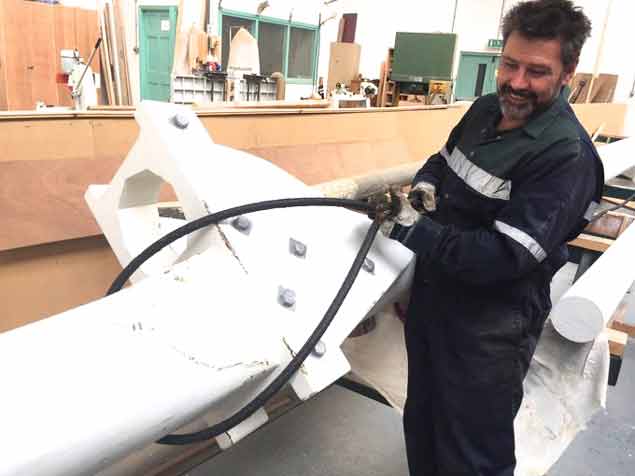 Trevor Ross with a new eye splice in the Ilen Boat-building School in Limerick. Photo: Gary MacMahon
Trevor Ross with a new eye splice in the Ilen Boat-building School in Limerick. Photo: Gary MacMahon
 The re-creation of Ilen’s rig, as developed by Trevor Ross with the late Theo Rye
The re-creation of Ilen’s rig, as developed by Trevor Ross with the late Theo Rye
Trevor Ross was professionally at sea for ten years, during which time he became fascinated with traditional rigging techniques. Though he now works ashore, his interest in traditional rigging and sail training is greater than ever - so much so that he worked with the late Theo Rye in finalizing the design of Ilen’s rig to match the original from Conor O’Brien’s day, while ensuring that it is practical in modern terms both for requirements of efficiency and safety.
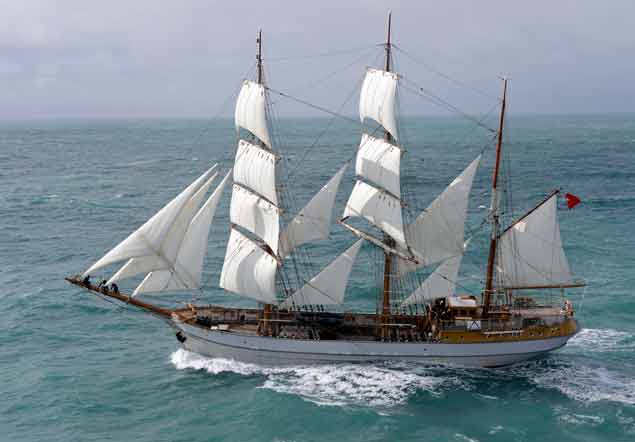 Captain Piers Alvarez’s current command is the 45-metre barque Kaskelot
Captain Piers Alvarez’s current command is the 45-metre barque Kaskelot
Piers Alvarez grew up in English cider country near the broad River Severn, but his personal horizons were far beyond apple growing. When he was 15, the captain of the famous square rigger Soren Larsen came to live in the village, which gave Piers’ father the opportunity to sign on his restless son as an Able Seaman at least for the duration of the school holidays, but the boy became hooked on the sea.
More than thirty years later, the love of seafaring and traditional ships is undimmed. Although Piers’ maritime career has also taken in tugs, superyachts and ice-classed research vessels, his current role in command of the Kaskelot perfectly chimes with his most passionate interests, and he has been fascinated by the entire Ilen project from an early stage.
So when the possibility arose of spending time in Limerick working along with his old shipmate Trevor Ross on the rigging for Ilen as a training project for the Ilen School’s intake, he readily gave up a week of his leave to teach the Ilen’s build team and future crew everything he knows, while moving a key part of the Ilen plan along the path of progress.
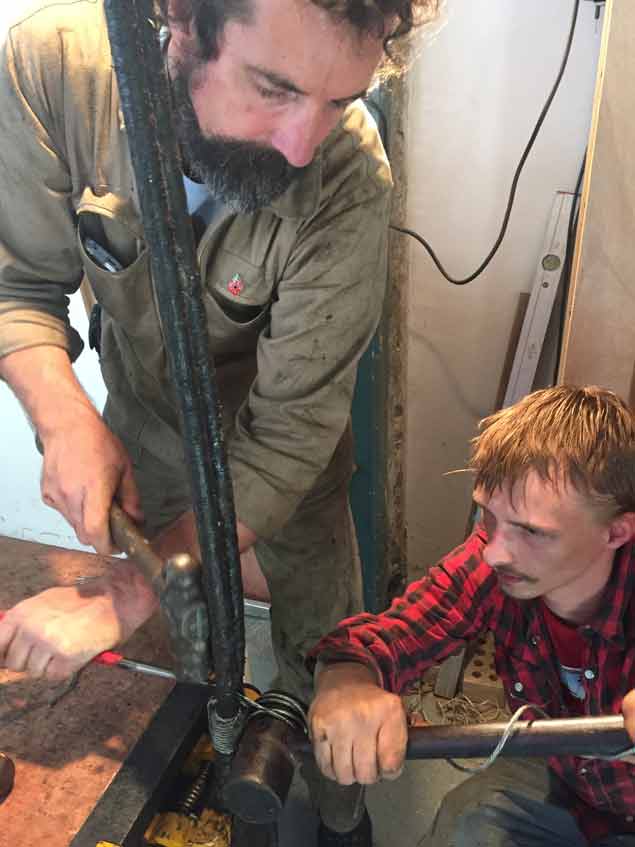 Piers Alvarez and trainee Elan Broadly busy with their work in Limerick
Piers Alvarez and trainee Elan Broadly busy with their work in Limerick
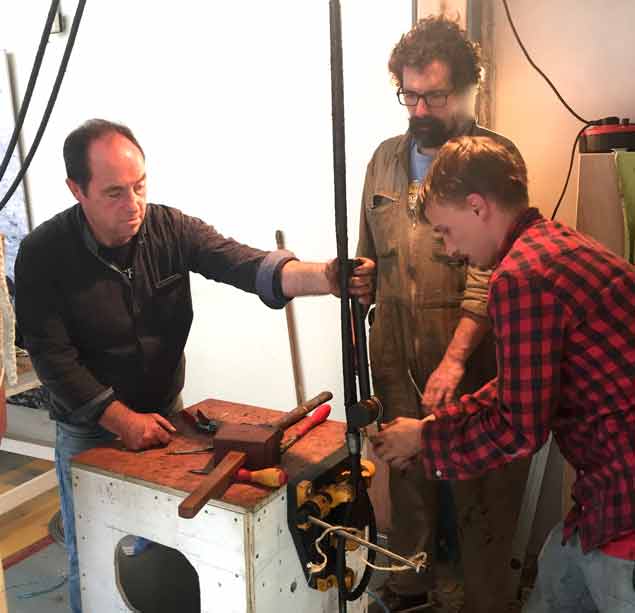 Ilen School Instructor James Madigan (left) with Piers Alvarez and Elan Broadly, immersed in their learning work while everyone else is on holiday. Photo: Gary MacMahon
Ilen School Instructor James Madigan (left) with Piers Alvarez and Elan Broadly, immersed in their learning work while everyone else is on holiday. Photo: Gary MacMahon
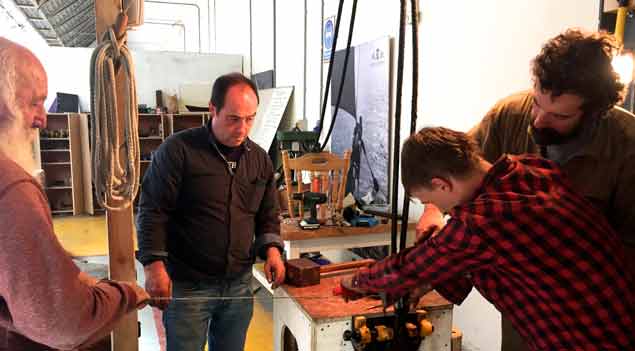 Team work. (Left to right) Liam O’Donoghue, James Madigan, and Elan Broadly on a steep learning curve with Piers Alvarez. Photo: Gary MacMahon
Team work. (Left to right) Liam O’Donoghue, James Madigan, and Elan Broadly on a steep learning curve with Piers Alvarez. Photo: Gary MacMahon
Modern amateur sailors, accustomed to today’s rigging where a terminal can be fitted in a seemingly-simple machine with the press of a button, can scarcely imagine the patient effort and skill which goes into making an eye splice in wire rigging which is of such a weight that, to most of us, it looks more like working with steel hawsers.
This is hard graft, but very rewarding in the result, and the satisfaction found in the effort expended. Much of it is done entirely by hand, but now and again that lethal multiple tool, the angle-grinder, will speed up a finishing job.
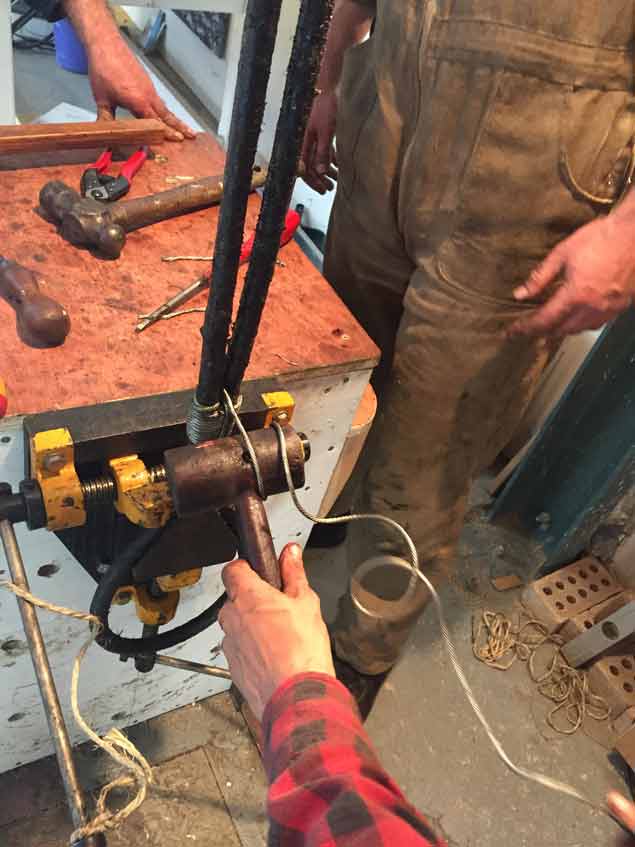 Some of the tools used in setting up traditional rigging are of very ancient origin…………….Photo: Gary MacMahon
Some of the tools used in setting up traditional rigging are of very ancient origin…………….Photo: Gary MacMahon
 ….but inevitably an angle grinder will be used at some stage, and Piers Alvarez is ace with it. Photo: Gary MacMahon
….but inevitably an angle grinder will be used at some stage, and Piers Alvarez is ace with it. Photo: Gary MacMahon
When finished, the neatly parcelled eye-spliced shrouds will fit the re-shaped mast like a glove, while at the other end, the shrouds will be tensioned by traditional lanyards through dead-eyes which have been made in Limerick from tough greenheart timber. It’s a long way from a drum of raw steel wire and a still squared hounds area to be progressed into something which will function on the massive mast in smooth partnership, providing Ilen with her sailing power. And in Limerick over the holiday week, it provided an unusually satisfying way to learn something new and useful.
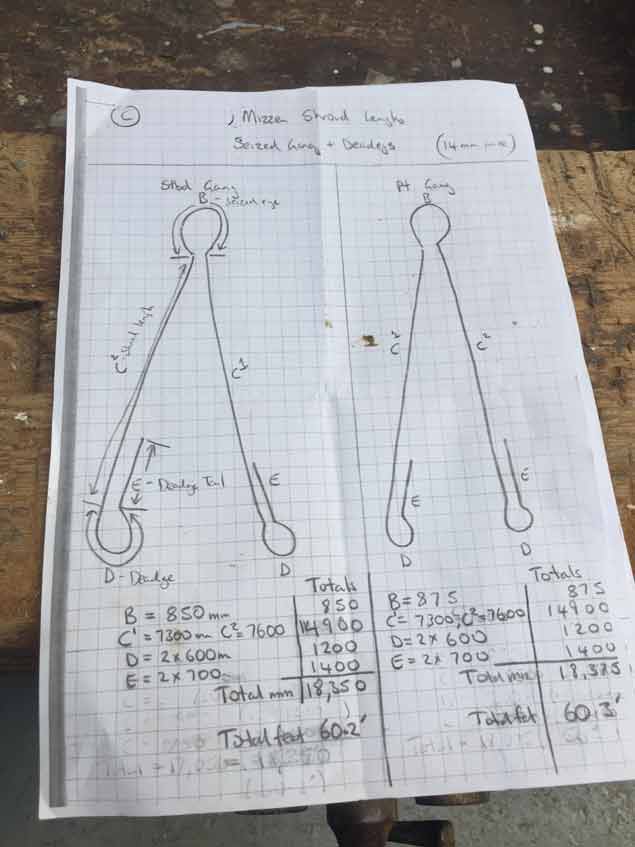 With the simplest of work drawings, an experienced rigger can turn a piece of hefty steel wire into a serviceable piece of rigging. Photo: Gary MacMahon
With the simplest of work drawings, an experienced rigger can turn a piece of hefty steel wire into a serviceable piece of rigging. Photo: Gary MacMahon
 The thick steel wire in its raw state is a daunting sight. Photo: Gary MacMahon
The thick steel wire in its raw state is a daunting sight. Photo: Gary MacMahon
 The lower ends of the shrouds will be attached to the chainplates by lanyards rove through deadeyes made from greenheart, seen here at an early stage of the shaping process in Limerick. Photo: Gary MacMahon
The lower ends of the shrouds will be attached to the chainplates by lanyards rove through deadeyes made from greenheart, seen here at an early stage of the shaping process in Limerick. Photo: Gary MacMahon
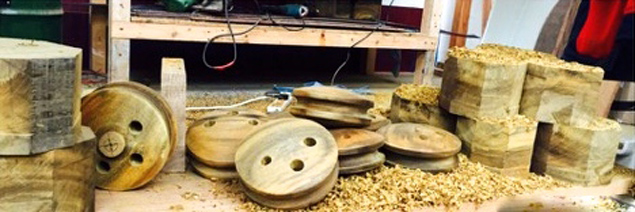 “Series production” of dead-eyes. Photo: Gary MacMahon
“Series production” of dead-eyes. Photo: Gary MacMahon
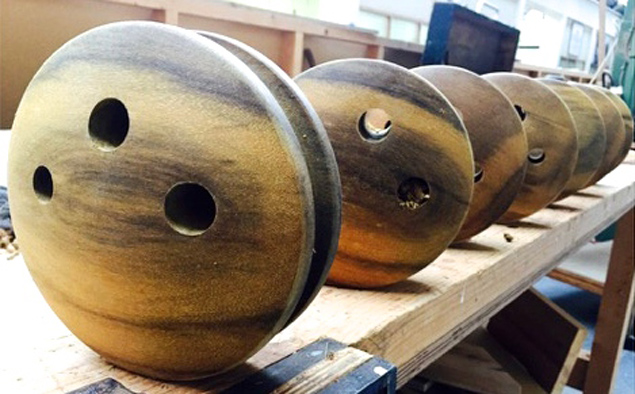 Dead-eyes at the final stage of their creation. All that remains to be done is to shape grooves to allow a fair downward lead for the lanyards. Photo: Gary MacMahon
Dead-eyes at the final stage of their creation. All that remains to be done is to shape grooves to allow a fair downward lead for the lanyards. Photo: Gary MacMahon
We well know from running stories now and again about the restoration of the Conor O’Brien 57ft ketch Ilen at Oldcourt near Baltimore for Limerick’s Ilen Boat-building School just what a high level of interest it arouses at home and abroad writes W M Nixon. So when this Community Invitation for the decking-out ceremony in nine days time pinged through the inbox, we thought for a moment about how best to publicise it. Then the spotting of a little typo allowed us to send a pompous email telling them that the curve of the top of the hull is the sheer, but if you want to shear, then you need sheep.
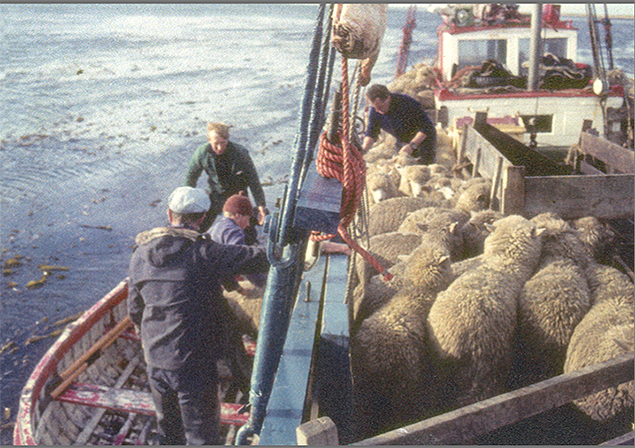 Ship sheep. Ilen takes aboard woolly passengers in her working days
Ship sheep. Ilen takes aboard woolly passengers in her working days
 Job done. After a successful shearing session, Ilen heads for home with bags of quality wool
Job done. After a successful shearing session, Ilen heads for home with bags of quality wool
You don’t pull the wool over the Limerick men’s eyes for long. Within minutes there came back the photo of Ilen’s deck well-filled with sheep during her working days in the Falkland Islands, and then another one with her foredeck topped-up with bags of wool after a successful shearing expedition.
That was followed in due course by a typo-free invite for the ceremony. It will be quite a party.
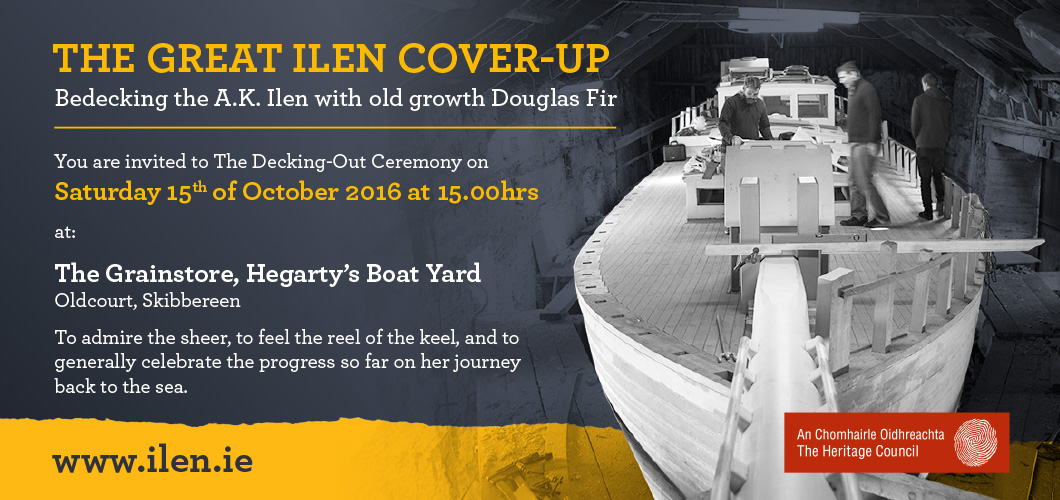 Ilen invitation all present and correct
Ilen invitation all present and correct
Wicklow Lifeboat Assists Yacht In Early Morning Callout
#RNLI - Wicklow RNLI's all-weather lifeboat launched at 5.32am yesterday morning (Wednesday 7 September) after the Irish Coast Guard received a call for assistance from a yacht in difficulties off the Wicklow coast.
The 10m British ketch, with two people on board, was on passage from Cornwall to Scotland when it developed steering problems, and its crew were having difficulty maintaining their course.
The lifeboat crew located the vessel in fog eight miles east of Wicklow Harbour at 6.10am. Conditions in the area had a southwest Force 3 with moderate sea and poor visibility.
The yacht was taken in tow back to Wicklow Harbour and was secured safely alongside the south quay at 7.45am.
This well known Oyster 39 ketch, (ex Morningtown) acted as the RORC escort and radio relay boat during the infamous 1979 Fastnet Race. She was responsible for relaying the positions of the racing fleet.
Her inventory includes a Ford 80HP diesel engine, wheel steering, nine berths, bow thruster, 3 blade varifold propeller, furling genoa, slab reefing mainsail, lazybag, colour chartplotter, radar, AIS, autopilot, life-raft, sprayhood and more.
She is a solid blue water cruiser and has been well looked after, according to Broker Hugh Mockler of Crosshaven Boatyard. More details here.
Christmas Dreams Of Irish Wooden Boats – Old & New, Real & Fantasy
The season is upon us for goodwill and dreams of very special gifts. And for many Irish sailors, the dream Christmas present would be an elegantly classic or solidly traditional wooden boat, with all maintenance and running costs somehow covered by Divine Providence into infinity……W M Nixon goes down the Yuletide timber trail.
Love of wood is part of what we are. It’s in our genes. At some times and some places in the remote past, an instinctive fondness for wood, and an inherited ability to do something useful with it, would make all the difference between survival and extinction. So though today the availability of other more purposeful materials may have transformed boat-building, a new boat without some sort of wood trim is a very rare thing indeed.
At a more personal level, many of today’s generation of sailors cherish family memories of the communal building of wooden DIY kit boats at home. Here, there and everywhere, a drawing room or little-used dining room found itself a useful new purpose as a boat-building salon, with Mirror dinghies and occasionally larger craft taking shape in domestic settings throughout the land.
“Our daddy the boat-builder” became a household name in his own household. And for those who sometimes wonder why today’s adult sailors can become misty-eyed at the very thought of the Mirror dinghy (which really was and is a wonderful design and concept), the answer surely is that at a significant stage of their sailing and family life, a Mirror dinghy was centre stage, the symbol of a family’s shared values, hopes and interests.
But maybe the most important thing about the Mirror is that she is so eminently practical. So perhaps at Christmas we should allow our imaginations to take flight and soar high to envisage the complete wooden dreamship. And there she is as our header image, introducing this week’s meandering thoughts. That schooner at the moment is total fantasy. But any sailing enthusiast who looks at that concept design and doesn’t think: “Now there’s my dreamship”, well, he or she just doesn’t have a true sailing soul.
The origins of Eirinn, as she is named for the time being, go back to 2012, when the nascent Atlantic Youth Trust sought suggestions as to what a new sail training vessel for all Ireland should look like. But with their proposals recently getting the first real hints of a fair wind from both governments, the AYT have gone firmly down the route of a 40 metre steel barquentine.

The Ilen as she was in the Spring of 2015 in Oldcourt...
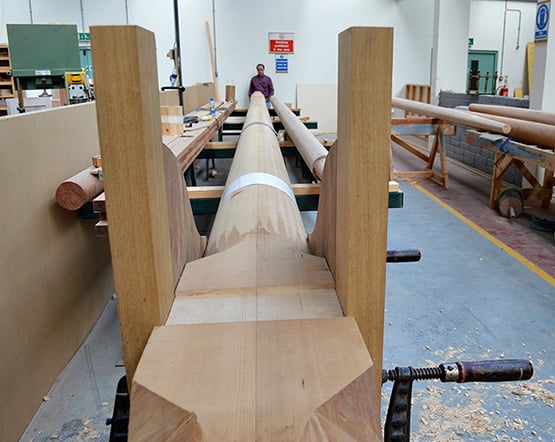 ….while in the Ilen Boatbuilding School in Limerick, spars and deckhouses were taking shape
….while in the Ilen Boatbuilding School in Limerick, spars and deckhouses were taking shape
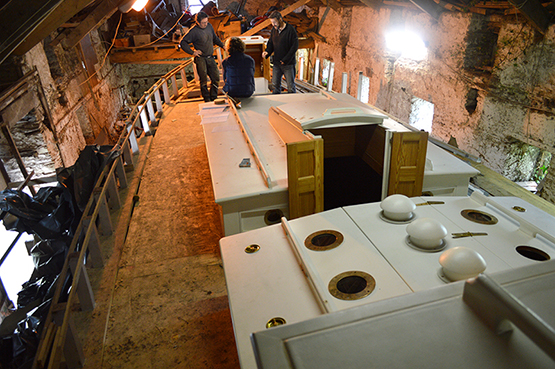
Deckhouses built in Limerick are offered up on the Ilen in Oldcourt
However, down in Limerick where they were busy with moving forward the restoration of the Conor O’Brien 1926 ketch Ilen at two sites – the hull with Liam Hegarty in Oldcourt near Baltimore in West Cork, and the deckhouses, spars and other smaller items being built at the Ilen Boat Building School in Limerick – they gave some thought in 2012 to the possible form of a new sail training vessel. They came up with the concept of a classic 70ft schooner which they knew, thanks to the work on Ilen, that they could build themselves using the skills learned and deployed in re-building the O’Brien ketch.
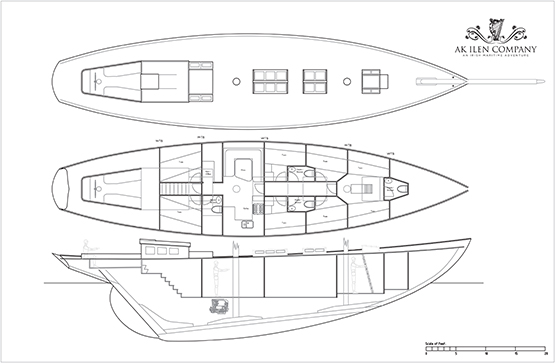
A classic hull for a classic schooner – Theo Rye’s profile and general arrangements plan for the schooner concept of 2012
But with the Ilen project moving steadily on towards the vessel’s commissioning next summer, and with other directly-related new proposals at an advanced stage in the pipeline, that sublime schooner concept is in a sort of limbo, truly a fantasy.
Yet she’s such a lovely thing that we’re happy to use her as our symbol of Christmas cheer. Her creators are Gary MacMahon of the Ilen Boatbuilding School, and Theo Rye, who is best known as a technical consultant in naval architecture, and on clarifying matters of design history and detail in boat and yacht design. But he can turn his hand to all sorts of design commissions if required. He came up with the clever concept for the CityOne dinghies in Limerick, and when Gary started musing about a classic training schooner, within the scope of what the Ilen school could do, as their answer to the AYT sail training vessel query, Theo came up with the goods and then some.
In fact, the design of the hull is so perfect that we’ll run it again right here to save you the trouble of scrolling back to the top. The overhangs at bow and stern are in harmony, but it is the sheerline which is the master-stroke. There isn’t anything you’d want to change in it, yet when you look at other famous schooners such as the fictional Southseaman (in real life she was Northern Light) in Weston Martyr’s masterpiece of maritime literature The Southseaman – the Story of a Schooner (1926), we see a sheerline which is too flat in the way of the foremast. But with Eirinn, the curve is just right, and it’s something achieved by tiny adjustments and balances which the eye can’t really perceive, yet somehow it registers the sublime harmony of the total concept.
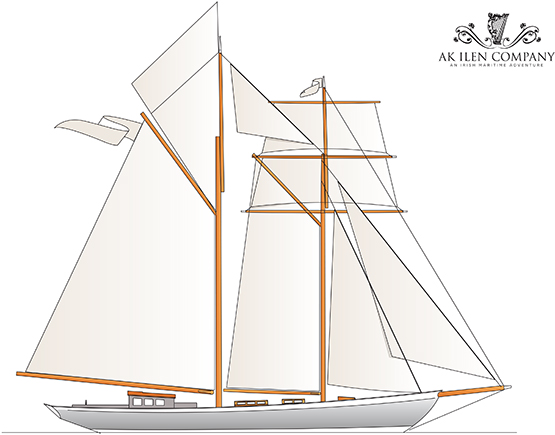
Worth a second look – and then a third one. The longer you look at the lines of Eirinn, the sweeter they seem. But her overall appearance might be improved with a slight rake of the masts
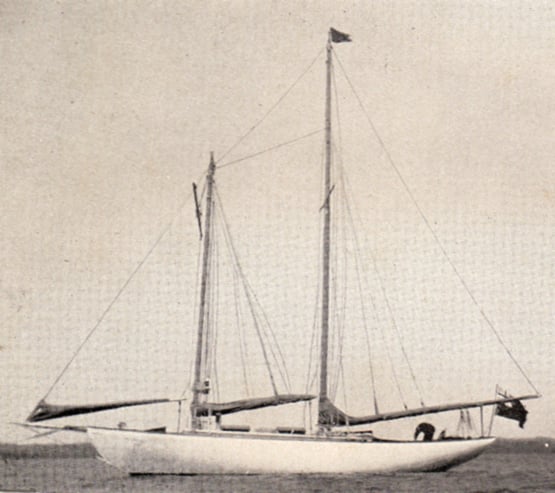 A schooner sheer not quite right – Weston Martyr’s Southseaman (aka Northern Light) could have done with a livelier sheerline abeam of the foremast.
A schooner sheer not quite right – Weston Martyr’s Southseaman (aka Northern Light) could have done with a livelier sheerline abeam of the foremast.
So Theo Rye not only writes critiques of other people’s designs, but if given the chance he can personally come up with something which is wellnigh impossible to fault. Of course, we mightn’t quite go for the same rig – a little bit of rake in the masts wouldn’t go amiss - and for private use you’d want something a little different from the dormitory layout of the training ship. But that said, this is a beautiful yet not excessively pretty-pretty hull, a boat which sings. And the fact that she’s beyond just about every private owner’s reach only adds to the mystique.
But to redress the balance, last week we’d an inspiring evening’s entertainment and information about a dreamship which really is being re-created. It was the December gathering of the Dublin Bay Old Gaffers Association in the ever-hospitable Poolbeg Y & BC, and a full house was there to hear about how Paddy Murphy of Renvyle in the far northwest of Connemara is getting on with his mission of bringing the famous Manx sailing nobby Aigh Vie back to life.
Paddy himself is something special. When asked his trade, he says he’s a blacksmith. But he can turn his hand to anything. Originally a Dub, his early sailing experiences included owning a Flying Fifteen and a Dragon, though not – so far as I know – at the same time. But then got the gaff rig traditional boat bug, and a sail on Mick Hunt’s Manx nobby Vervine Blossom sent him in pursuit of near-sister Aigh Vie. She was reportedly for sale, having for a long time been the pet family cruising boat of Billy Smyth and his family at Whiterock Boatyard on Strangford Lough, after spending her final working years fishing as a motorized vessel out of Ardglass.

Aigh Vie as she was in Whiterock Boatyard when Paddy Murphy bought her, her elegant huul shape clearly in evidence
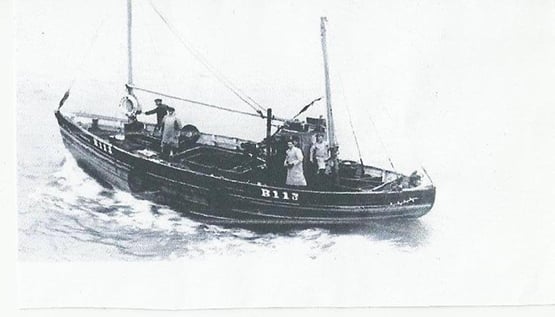 Aigh Vie in her final working days as a motorised fishing boat based at Ardglass
Aigh Vie in her final working days as a motorised fishing boat based at Ardglass
The deal was done, an ideal buy for a special man like Paddy Murphy, for the Aigh Vie is one very special vessel. The Manx fishing nobbies reached their ultimate state of development in the first twenty years of the 20th Century before steam power and then diesel engines took over. The nobby evolved to an almost yacht-like form through vessels like the 43ft White Heather (1904), which is owned and sailed under original-style dipping lug rig by Mike Clark in the Isle of Man, and the 1910 Vervine Blossom, now based in Kinvara, which was restored by Mick Hunt of Howth, but he gave her a more easily-handled gaff ketch rig which looked very well indeed when she sailed in the Vigo to Dublin Tall Ships Race in 1998.
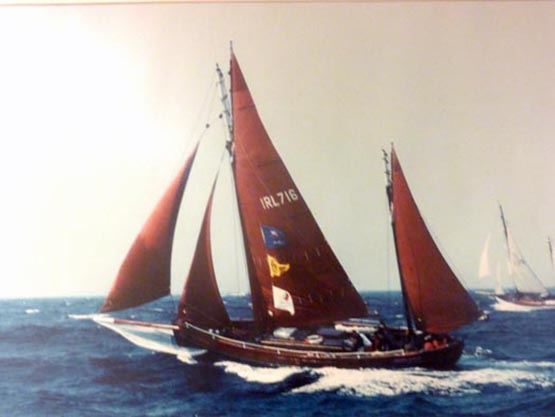
It was a sail on Mick Hunt’s 1910-built Manx nobby Vervine Blossom which inspired Paddy Murphy to go in pursuit of Aigh Vie
It takes quite something to outdo the provenance of these two fine vessels, but the story of Aigh Vie (it means a sort of mix of “good luck” and “fair winds” in Manx) is astonishing. It goes back to the sinking of the Lusitania by a German U Boat off the Cork coast in May 1915, when the first boat to mount a rescue was the Manx fishing ketch Wanderer from Peel, her crew of seven skippered by the 58-year-old William Ball.
They came upon a scene of developing carnage. Yet somehow, the little Wanderer managed to haul aboard and find space for 160 survivors, and provide them with succour and shelter as they made for port. In due course, as the enormity of the incident became clear, the achievement of the Wanderer’s crew was to be recognised with a special medal presentation. And then William Ball, who had been an employee of the Wanderer’s owner, received word that funds had been lodged with a lawyer in Peel on behalf of one of the American survivors he’d rescued. The money was to be used to underwrite the building of his own fishing boat, to be built in Peel to his personal specifications. The name of the donor has never been revealed, but the result was William Ball’s dreamship, the Aigh Vie, launched in December 1916 and first registered for fishing in January 1917.
Over the years, the Aigh Vie became a much-loved feature of the Irish Sea fishing fleet. Tim Magennis, former President of the Dublin Bay Old Gaffers Association, well remembers her from his boyhood days in the fishing port of Ardglass on the County Down coast. Her working days over, Billy Smyth gradually converted her to a Bermudan-rigged cruising ketch with a sheltering wheelhouse which enabled the Smyth family to make some notable cruises whatever the weather. His son Kenny Smyth, who now runs the boatyard with his brothers and is himself an ace helm in the local 29ft River Class, recalls that the seafaring Smyth family thought nothing of taking the Aigh Vie to the Orkneys at a time when the average Strangford Lough cruiser thought Tobermory the limit of reasonable ambitions.
After he’d bought the Aigh Vie and brought to her first base in Howth, Paddy Murphy soon realised he’d still a lot to learn about sailing and about keeping hard-worked old wooden boats in seafaring condition. But he’s such an entertaining and inspirational speaker that you’re swept along in his enthusiasm and empathise with his admission that, now and again, he felt things were getting on top of him.
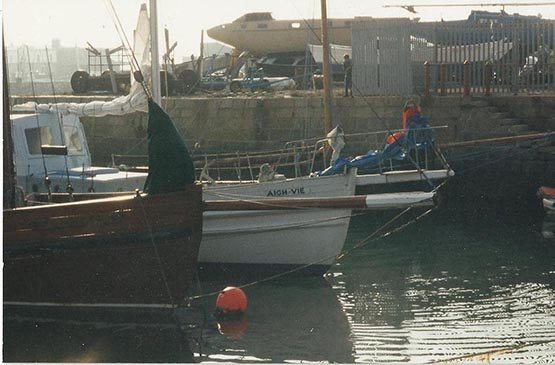
Sisters - Vervine Blossom (foreground) and Aigh Vie in Howth
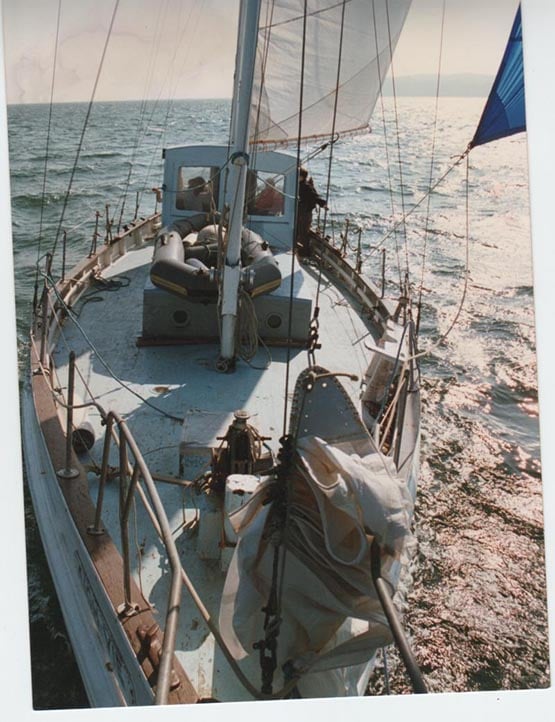
Sailing days on the Aigh Vie from Howth, before it was decided that she needed a major restoration
Following several seasons with increasing evidence of problems, he decided that a virtual re-build was necessary. It was then that the Dublin wooden boat owners’ perennial problem shot to the top of the agenda. In our very expensive city, the space and shelter to work long hours at an old wooden boats is almost impossible to come by, and he’d to shift the big Aigh Vie several times. On one occasion, he was asked to move in a hurry out of an ESB shed, but was offered £1,000 (this was pre-Euro days) to do so. He moved heaven and earth and finally found somewhere else at considerable expense, got the Aigh Vie installed there, and then went back to collect his thousand snots. Only to be laughed at. The manager told him it was the only way he could see to get the old boat moved out, but there were absolutely no funds available at all for such a thing, and surely Paddy would have guessed that?
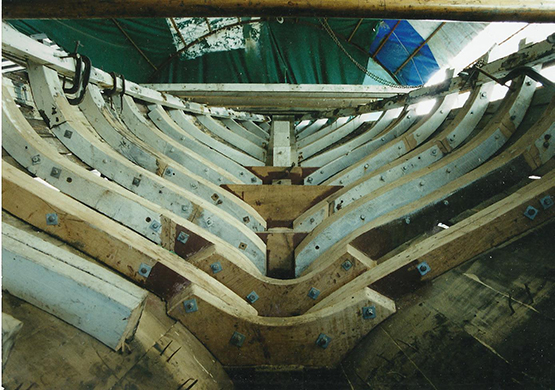
The re-building under way at Renvyle, using the technique where hull shape is retained by first replacing every other frame
With one thing and another, he moved to Renvyle in Connemara where he liked the big country and the open spaces and the friendly people right on the edge of the Atlantic, and in time Aigh Vie came too, and found herself being slowly re-born under a special roof. But it was demanding work for one man, so every so often a team led by Paul Keogh of the famous Galway Hooker from Clondalkin, the Naomh Cronan, together with a good selection of DBOGA specialist talent, descends on Renvyle to put in a ferocious day or two of work, and then on the Saturday night they put a fair bit of business the way of the pub at Tullycross.
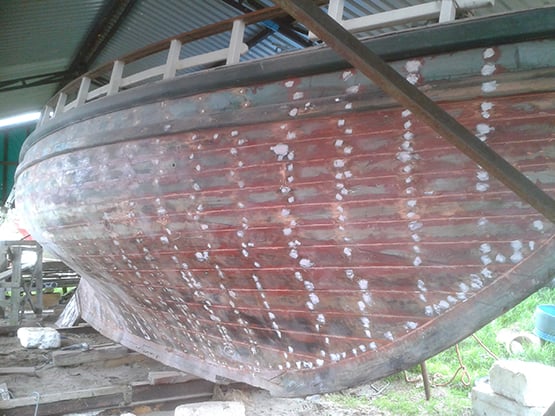
The planking was more easily restored by laying the Aigh Vie over on her side
Agh Vie upright again, and the deckhouses are being put in place
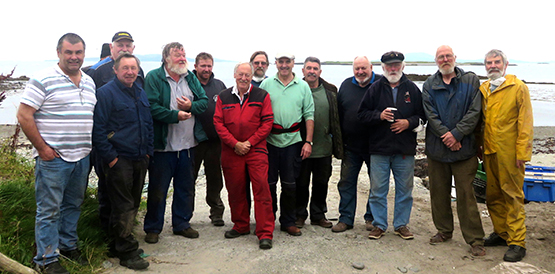
Old Gaffers Association International President Sean Walsh (right) and Peter Redmond install Aigh Vie’s new Perkins diesel. Photo: Cormac Lowth

One of the options for Aig Vie’s rig is the classic lug ketch as shown here with Mike Clark’s 1903-built White Heather
So now, many years later, the journey towards the restored Aigh Vie is getting near its destination. But it will never be fully ended. Thanks to sails, spars and rigs donated from other boats, Paddy has the choice of either gaff ketch or classic lug rig, so she’ll always be work in progress. Which is good news. Because every couple of years or so, the DBOGA can guarantee a full house to hear Paddy Murphy talking about how the Aigh Vie story is going.
He’s a wonderful speaker, sometimes almost messianic, and he shares his every feeling. Thus he mentioned that one day he was feeling a bit low, and he just went out to look at the big boat down by the shore, seeking some sort of inspiration. His mind had been elsewhere with the details of completing the interior, but he suddenly realised that he was at the stage of thinking of putting the white paint on the topsides. So he just set to with a big paint brush and a bigger tin of paint, and Aigh Vie was transformed. So was he. “That’s the secret” says he. “If you’re feeling a bit down, just go out and slap on some white paint. It works wonders.”

Feeling a bit down? Then just go out and slap a coat of white paint on the boat – it works wonders
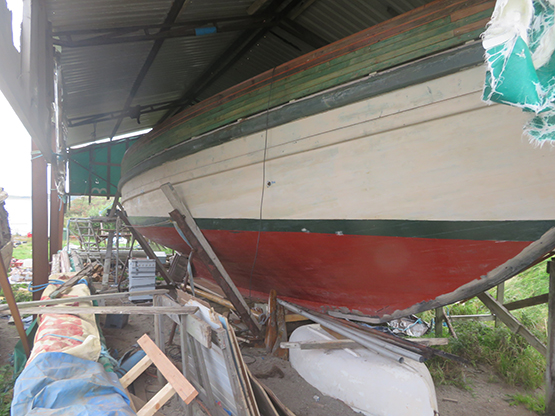
Dublin Bay Sailing Partnership Based on Artistic Endeavour
#iris – It has been said that keeping a boat-owning partnership intact is much more difficult than maintaining a marriage in a healthy state. Thus for most of us with the boat-owning vocation, sole ownership is the only way to go. But for others, in order to defray costs, increase boat size, and maybe leave more personal time free to pursue other interests, the ambitions can best be realised through one of a wide variety of partnerships and syndicates.
These can go through an extensive range, starting at one extreme with what amounts to time-sharing, with the large number of owners meeting (if they meet at all) only once a year for a sort of Annual General Meeting. Other possible setups can mutate through various arrangements where there is considerable overlap between the boat uses by the different owners, right through to the other extreme of total partnership where all owners sail together as often as is possible.
In some cases, the additional social glue of special shared interests is needed to give the partnership that essential extra vitality. There's nothing new in this. W M Nixon takes a look back a hundred years and more to a boat-owning group whose shared interest in art kept a 60ft ketch on a regular cruising programme around Dublin Bay and the nearby coastlines.
The 60ft gaff ketch Iris had a chequered career. She started life at the peak of the Victorian era in the 19th Century as a naval pinnace serving Dublin Bay, and she was presumably driven by steam. At the time, Dun Laoghaire – then known as Kingstown – was becoming the height of fashion as a naval port of call in the summer, made even more so by its convenient access to the centres of power in Dublin, and its strategically useful direct rail connection – pierhead to pierhead – to the main Royal Navy base in Ireland at Cobh on Cork Harbour.
However, as Kingstown had initially been planned solely as a harbour of refuge – an asylum harbor - for ships in distress in onshore gales, with the actual spur to its construction (starting in 1817) being the wrecking of a British troopship with huge loss of life at Seapoint on the south shore of Dublin Bay, the plans had included no provision for convenient alongside berthing for ships.
Indeed, you get the impression that the original underlying thinking was that there should be as little social contact as possible between ships sheltering in the new harbour and any inhabitants of its nearby undeveloped shore. But the rapid if somewhat chaotic growth of the makings of a new harbourside town, plus the advent of more rapid access from Dublin with the coming of the railway in 1834, soon meant that the top brass expected to be able to get off and on their ships in the harbour in style and comfort, and their Lordships of the Admiralty did not stint in providing large pinnaces for them to do so. When these pinnaces were replaced in due course by even more luxurious vessels, those shrewd amateur sailors who could visualise the older boats' potential as re-cycled government surplus found themselves looking at a bargain.
The Iris was originally built with lifeboat-style construction of double-diagonal hardwood planking, which was quite advanced technology for the time. For the can-do boatbuilders of the late 19th Century, converting such totally purpose-built craft into some sort of a yacht was all part of a day's work. Another similarly-built if smaller and different-shaped vessel, Erskine Childers' Vixen on which the Dulcibella of The Riddle of the Sands fame was based, was formerly an RNLI lifeboat with the standard lifeboat canoe stern. She was made more yacht-like by the addition of a staging aft to compensate for the absence of deck space just where you most need it, while underneath this new permanent staging, additional supporting planking was faired into the hull and – hey presto – you've a yacht-like counter stern.
Vixen also had a massive centre-plate complete with its huge casing, and carried more than three tons of internal iron ballast, all of which left little enough space for living aboard during the long and often rough cruise through the Friesian Islands which provided much of the on-the-ground material – and we can mean that in every sense – on which The Riddle was based.

Erskine Childers' Vixen (on which "Dulcibella of The Riddle" was based) in one of his last seasons of ownership in 1899. At first glance, she looks like a typical old-style cruising cutter of her era. But somewhere in there is a classic canoe-sterned RNLI lifeboat hull to which an afterdeck on a counter stern have been fitted as an add-on.
That cruise was in 1897, and shortly after it was completed, Childers went off to serve in the Boer War. This experience left him with doubts about the validity of the British Imperial mission, but equally left him in no doubt that on active service, there were no medals for enduring unnecessary discomfort. So by the time The Riddle of the Sands was published in 1903, Vixen was sold and he'd become a partner in a much more comfortable cruising boat, the yawl Sunbeam, which in turn was followed in 1905 by his very comfortable dreamship Asgard
Meanwhile, with the Iris a fifteen or so years earlier in Dublin, the conversion to a comfortable sailing cruiser was a more straightforward affair, as she'd a more versatile hull shape with a broad stern in the first place, and her new owner was one George Prescott, an innovator bordering on genius. He was an optical and scientific instrument maker, an electrical engineer and inventor, and a state-of-the-art clockmaker.
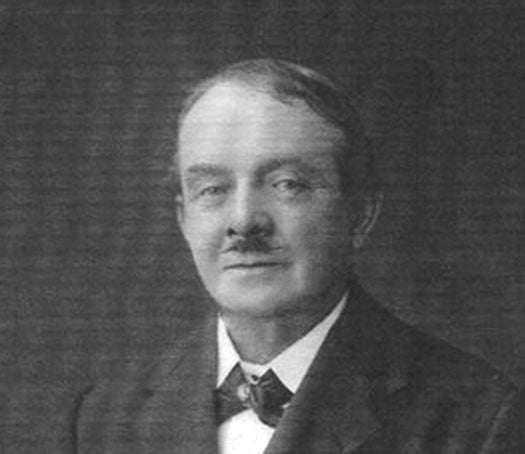
Man of many parts – the polymath George Prescott. Organising the Graphic Cruising Club and running its club-ship Iris was only one of his many interests. He led a long and extraordinarily interesting and varied life, and was nearly a hundred years old at the time of his death in 1942. Courtesy Cormac Lowth
But that was only one part of his life, for he had many friends among Dublin artists, particularly those interested in maritime topics, and he soon found himself to be the secretary of the Graphic Cruisers Club for sailing painters and sketchers, with the Iris becoming the base of their waterborne creative and scientific expeditions on the coast of the greater Dublin area.
She was ideal for this. She'd been converted for sailing with an orthodox gaff ketch rig, while her roomy hull was internally re-configured to have a galley with a large stove right aft, a huge saloon immediately forward of the galley to be both the clubroom and dining room, and sleeping quarters port and starboard in pilot cutter style forward of that.
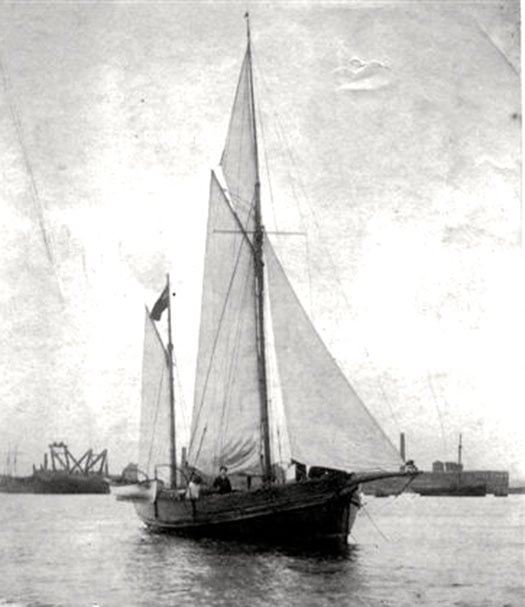
Quite a transformation for a former steam-powered naval pinnace. The 60ft ketch Irish in her heyday as the club ship of the Graphic Cruisers Club in the 1890s. She is at her home anchorage off Ringsend, while across the Liffey a couple of Ringsend trawlers are lying in the roadstead known as Halpin's Pool, where the Alexandra Basin is now located. Photo courtesy Cormac Lowth

Accommodation profile of the Iris in her days as the floating HQ of the Graphic Cruisers Club – this sketch by Alexander William first appeared in The Yachtsman magazine in 1894.
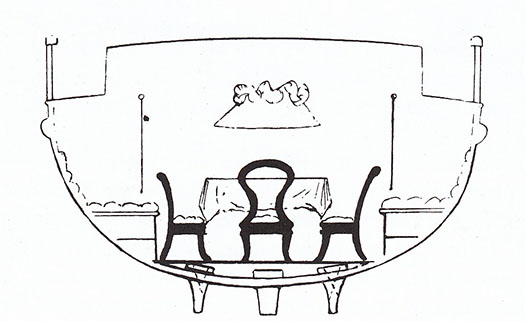
Hull section of the Iris at the saloon, showing the bilge keels which enabled her to dry out comfortably in some some little-known tidal anchorages in the Greater Dublin area.
But underneath the hull, the temptation had been resisted to add a deep keel, and instead the Iris was fitted with substantial bilge keels at the same depth as the shallow keel itself, such that in all she drew only about 3ft 6ins, and would comfortably dry out in a snug berth anywhere that her artistic crew felt they might find subjects worthy of their attention.
Thus she might overnight serenely on the beach at Ireland's Eye or far up the estuary at Rogerstown, and if the Graphic Cruisers Club attention was turned towards County Wicklow, she could comfortably take the ground in Bray or in other little ports inaccessible to orthodox cruising yachts. Yet the claim was that despite the odd arrangements beneath the waterline, she handled remarkably well on all points of sailing, and certainly as she no longer had any sort of engine, she must have sailed neatly enough to get out of some of the confined berths into which her eccentric crew enjoyed putting her.
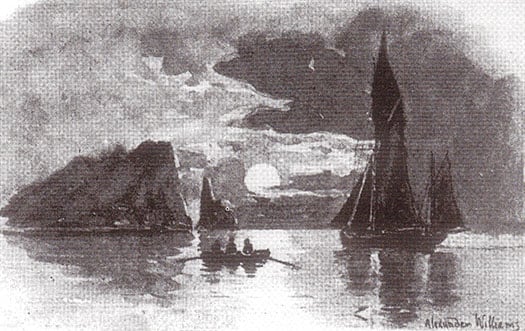
The Iris in gentle cruising mode off Ireland's Eye as the moon rises – this was sketched by Alexander Williams for The Yachtsman in 1894.
George Prescott seems to have been happy to claim that Iris was a club-owned yacht, but in truth most of his shipmates were impecunious artists of varying talent, so it was his generosity and understated business ability which would have kept the partnership together.
However, it really did seem to function as a partnership, for after the Iris project had been up and running for nearly a decade, he turned his attention in 1896 to building an unusual house on the waterfront on the Pigeonhouse Road in Ringsend, which he happily acknowledged to be the clubhouse of the Graphic Cruisers Club even if he lived in it himself.
Called Sandefjord for some reason which is still unexplained, it looked not unlike a smaller sister of the Coastguard Station next door, complete with a lookout tower. And it's distinctly nautical within, as much of the interior includes fine panelling which came from the wrecked Finnish sailing ship Palme, with the stairs being provided by the old ship's main companionway.
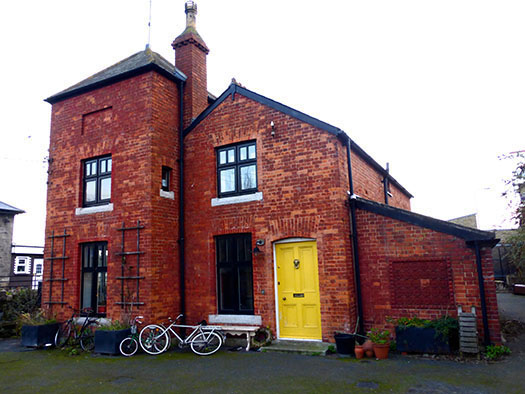
The house called Sandefjord near Poolbeg Y & BC as it is in 2015. When built by George Prescott in 1896, it faced across the Pigeonhouse Road directly onto the waterfront, and overlooked the summer anchorage of the Iris. Photo: W M Nixon
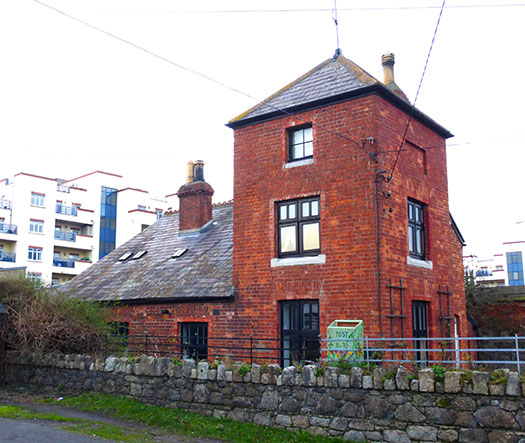
The design style of the Graphic Cruisers Club shore HQ at Sandefjord reflected the lookout tower of the old Coastguard Station next door. Photo: W M Nixon
The house has been restored to become a family home in recent years, and it really is an extraordinary piece of work to come upon on the slip road down to Poolbeg Yacht & Boat Club. Meanwhile, interest in the doings of the Graphic Cruisers Club has been restored by the formidable research talents and tenacity of Cormac Lowth, who single-handedly does more work in uncovering unjustly ignored aspects of Dublin Bay's maritime life in all its variety than you'd get from an entire university department.
I first came across a reference to the Graphic Cruisers Club years ago in an article in an 1894 issue of The Yachtsman magazine, written by Alexander Williams (1846-1930), who was probably the club's most accomplished marine artist. But that was then, this is now, and it has taken Cormac Lowth's dedication in recent times to get the extraordinary setup around George Prescott and Alexander Williams and their friends and shipmates into the proper context.
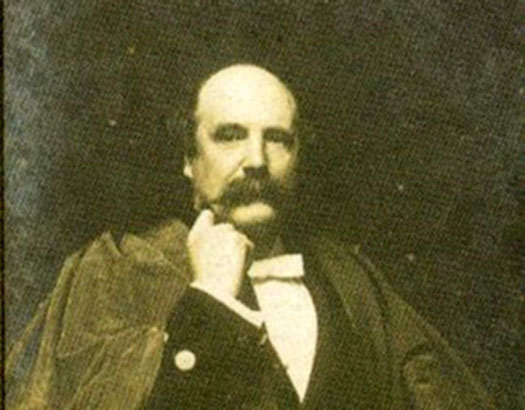
Alexander Williams RHA was the best-known artist in the Graphic Cruisers Club. A taxidermist of international repute, he was also a noted ornithologist, and his interest in maritime subjects was matched by his enthusiasm for landscape. He was one of the first artists to "discover" Achill Island in the west of Ireland, and in time he created a remarkable garden there in a three years project in which he personally worked shoulder-to-shoulder with the build team.
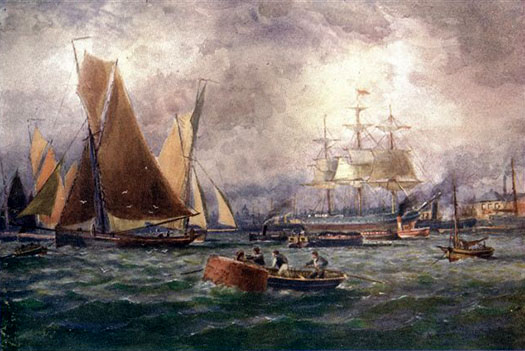
A classic Alexander Williams portrayal of the trawlers of Ringsend with other shipping in the Liffey. Thanks to research by Cormac Lowth, we are now aware of how the style of the Ringsend sailing trawlers came about through links, between 1818 and the 1914 outbreak of Great War, with the pioneering fishing port of Brixham in Devon, which was the most technologically advanced fishing port in Europe in the mid 1800s. Courtesy Cormac Lowth
They were larger than life, every last one of them, and Prescott and Williams in particular were renaissance men who could turn their hand to any number of creative projects at a time when life around Dublin was fairly buzzing for those with the energy and interest to enjoy it.
And there were links to other aspects of Dublin waterfront life which have a further resonance. Back in January, I'd to give one of the supper talks at the National YC in Dun Laoghaire, and on this occasion the topic was John B Kearney (1879-1967), the Ringsend-born yacht designer and boatbuilder who was the club's Rear Commodore for the last 21 years of his life.
You need some sort of special little link to bring these talks to life, but fortunately I remembered that there's a fine big Alexander Williams painting of sailing trawlers at Ringsend in the NYC's dining room. I didn't know its date as we headed round the bay on the night of the talk, but we struck gold. It was dated 1890.

The Brixham style in Ringsend was best exemplified by the largest trawler built in the Dublin port, the St Patrick (right) of 53 tons built in 1887 in the Murphy family's boatyard beside the mouth of the River Dodder. The Murphy family also owned and operated the St Patrick in her fishing, and when John Kearney built his renowned yachts, the earliest (and best) of them were built in a corner of Murphy's Boatyard - the Ainmara in 1912, the Mavis in 1925, and the Sonia in 1929. Photo courtesy Cormac Lowth
Williams was so fond of the Ringsend scene that he lived there for a while in Thorncastle Street where John B Kearney was born, and of course the painter subsequently sailed regularly from the old port in the Iris, and would have over-nighted at Sandefjord too. He is in fact the definitive Ringsend maritime artist, and the picture in the NYC expresses this. And as it includes some of the Ringsend waterfront, we could say that it also includes John B Kearney, for in 1890 the precocious eleven-year-old Ringsend schoolboy was in the boatyards as much as possible, as he had already stated in his quietly stubborn way that his ultimate ambition was to be a yacht designer.
Not a boatbuilder or a shipwright or a harbour engineer, which is nevertheless what he was until he retired in 1944. But upon his leaving the day job - in which he'd been highly respected - he then devoted all his energies to what he had been doing all his life in his spare time. And with his death aged 88 in 1967, his gravestone in Glasnevin cemetery said it all: John Breslin Kearney (formerly of Dublin Port & Docks Board) Yacht Designer.
And if you wonder how on earth we have come to a consideration of John Kearney's memorial stone in an article which purports to be about the social glues which keep boat partnerships in good order, believe me when you get involved with the boys of the Graphic Cruisers Club you never know where it's all going to end.
We've already discovered that in later life Alexander Williams devoted much energy to his garden in Achill while at the same time continuing to be an active member of the Royal Hibernian Academy in Dublin. As for George Prescott, he too broadened his already extensive interests, and in his eighties he was much into amateur opera production, even being so deeply involved as to paint the stage scenery himself.
Dublin too was expanding, so he accepted that a move eastward was needed if he was going to be able to continue to commune directly with his beloved sea. So he left Sandefjord, and the final decades of his wonderful life were spent at his new home at The Hermitage on Merrion Strand. Needless to say, Alexander Williams provided him with a painting of The Hermitage which captured the then unspoilt nature of a place you'd scarcely recognize today.
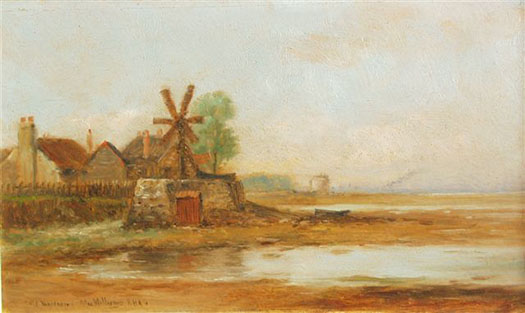
The Hermitage on Merrion Strand, George Prescott's last home as portrayed by Alexander Williams. Courtesy Cormac Lowth
IWDG Secures 75% Funding for Celtic Mist Refit
#TALL SHIPS - The Irish Whale and Dolphin Group (IWDG) has secured three-quarters of the funding it required to refit its research vessel Celtic Mist.
According to The Irish Times, the Clare Local Development Company has approved the allocation of a €48,000 grant towards the refurbishment of the ketch.
The work will be carried out by Cathal Blunnie and several sub-contractors, and involves stripping down the main cabin and removing the bath and shower to increase space for crew berths.
While the ship's clock will be retained, the ship’s wheel in the main cabin will be removed and presented to the Haughey family as a gesture of appreciation.
As previously reported on Afloat.ie, the 52-foot yacht - which was gifted by the Haughey family to the IWDG to assist in its marine wildlife conservation work - entered dry dock last November in preparation for the refit work, after relocating to its new berth at Kilrush, Co Clare in July.
This followed its last jaunt at sea in its former guise, completing a leg of the Tall Ships Races from Waterford to Greenock in Scotland.
The cost of refurbishing the yacht for research and training purposes is expected to top €60,000, with an annual running cost of some €20,000, for which the IWDG is seeking ongoing financial assistance.
The group aims to get the Celtic Mist back at sea before the summer.
IWDG Hopes Day Trips Will Keep Celtic Mist Afloat
#TALL SHIPS - Not only has the Celtic Mist finally been lifted into dry dock for refurbishing this week, but the Irish Independent reports that day trips will be offered on the yacht when it returns to the water next summer.
As previously reported on Afloat.ie, the one-time personal yacht of the late Taoiseach Charles Haughey is being repurposed as a research vessel by new owners the Irish Whale and Dolphin Group (IWDG) at a cost of some €60,000.
In an effort to help fund the 52-foot ketch's refit bill and its estimated €20,000-per-year running costs, members of the public who pay €50 for a 'Celtic Mist Certificate' will be entitled to a day's sailing on board the newly retitled RV Celtic Mist.
IWDG co-ordinator Dr Simon Berrow said: "We've a lot of work to carry out on the yacht before we can take it out for research," IWDG co-ordinator Simon Berrow told the Independent. "We are confident that we can raise the money to run it."
Here's a link to a TV3 clip
Conserving Historic Vessels
John Kearon – who is himself from Arklow – is one of the foremost in this field, with a distinguished career centred on the historic ships programme in Liverpool. His patient work, in making Asgard a non-seagoing conserved version of the vessel as she was when Erskine and Molly Childers had her built as a wedding present from her Molly's father, has clarified design features which had been lost in alterations made in the 1930s and the 1960s.

John Kearon with Asgard in Collins Barracks at an early stage of the conservation. Photo: W M Nixon
The quality of his research and craftsmanship has also helped in deciding Asgard's future. It is right that she should be conserved rather than restored. But if any group wishes to build a sailing replica, then the definitive plans are now available.
The features on aspects of Asgard's conservation are only part of a very comprehensive extensively illustrated book which covers historic ships and boats of any types. Naturally there's a significant element of serious academic insight. But those of us who are fascinated by all craft immediately warm to a learned volume which, despite its adherence to historical rigour and correctness, nevertheless refers to each vessel as "she".
WMN
Understanding Historic Vessels-Volume 3
Published by National Historic Ships, £30.
www.nationalhistoricships.org.uk



























